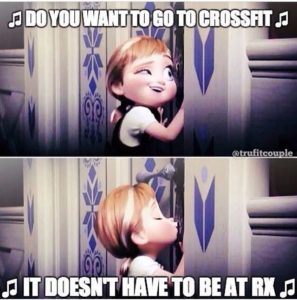
Today we are going to dive into how different people break up the same workout. One of the great things about CrossFit WODs is that they can be broken down and approached differently for everyone. Depending on what your fitness goals are, what skills you do or do not have or just how you are feeling on any given day.
This week we did a workout that had three movements. This workout had a 155lb/105lb Front squats for 10 reps, 10 pull ups and 10 bar facing burpees. This workout also required 4 rounds to be completed for time. We will be using this WOD as an example due to the fact that it is a great example of challenging strength as well as technical ability.
The time window for this workout was anywhere between 7 to 16 minutes. The averages were somewhere between 12 to 14 minutes. When scaling or approaching this wod you have to decide whether you want to have a strength/skill based wod or want it it to be a lung burner/cardio intensive workout. For the front squats the prescribed weights for most people are not to be light. Looking at the prescribed weight would suggest that the bar is meant to be heavy. Meaning the squats are not to be unbroken for the entire workout. If you are someone that has strength as a higher priority, moving towards the prescribed weight and knowing to break up the squats into smaller sets, should be your thought process in this workout. This may drop the heart rate a little and slow you down during this phase of the workout, but if strength is your priority, this approach will be better for you. Remember you can increase your heart rate through the roof if you push harder on the pull ups and the bar facing burpees. If you are someone that has plenty of strength, but you want to focus on the conditioning piece of the workout, choose a weight that you will be able to complete as an unbroken set to really challenge the lungs. The pull ups could fall under a similar thought process when it comes to picking a resistance band or choosing to not use a band at all. Pacing out the pull ups in order to not fail reps and get better at RX’d pull ups may be your priority because RX pull ups is something you have been chasing. There is always a balance when it comes to weighted movements of which is the priority and stamina versus cardio vascular output.
Another aspect of a WOD with different movements is how different technique affects output and how the challenge changes. Again, let us look at the pull ups in the example workout. Let’s say that you are starting to learn how to butterfly because your gymnastic kip has become reliable. When you are first learning new technique such as butterfly pull ups it will challenge your coordination and eventually you will have to slow down in order to maintain decent form with your new skill. Similar to double unders when you first learn them and the number you can do in a succession slowly goes increases over time. You may be able to get a faster time if you used your gymnastic kip, but with that option you will never learn to perform butterfly pull ups under duress. The overall system may get a bit of a break and the average intensity may drop, but once the technique is established it will increase the power output through the roof. Keep in mind that the better you are at butterfly pull ups the better you may become at other gymnastic/full body movements as a byproduct of taking the time to learn a more advanced skill.
At this point in the workout most people probably would not give burpees much of a thought. Especially after all the dissection of the first two movements. The bar facing burpee offers plenty to think about though. If you are someone like me that has never been great at just regular burpees, bar or bar facing burpees are the bane of your existence. However, there are several parts that can allow for some great simple gymnastic practice. Focusing on the jumping phases, both the jump out and jump in, should be done with purpose rather than just stepping in and out. This builds a better connection from the arms to the legs. If you are someone that struggles with kipping movements, this is a great opportunity to practice that connection on a horizontal plane and build that skill. Especially on the jump into the hands, if you can effortlessly jump the feet back towards the hands and keep the legs together while landing flat footed, you will definitely have less trouble reaching up to the bar for toes to bar. When it comes to the bar jump, if you are someone that has trouble with box jumps because you are not comfortable with jumping, here is a low risk chance to build confidence in that skill! Just like the pull up discussion above, jumping in may take more energy and slow you down rather than stepping in or out of the burpee. But stepping in and out can hold a better pace for most and therefore offer a higher intensity for the workout. Again, deciding your priority for the day is key here. Exchanging some technique practice for some higher cardiovascular training can change from day to day and you never have to stick to one approach. I would actually say to make those decisions daily and remember them. This will help your training progress with more awareness and intent, which is always good when you are in a long term practice like this!
Coach P
